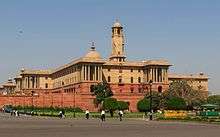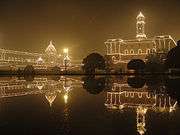Secretariat Building, New Delhi
Coordinates: 28°36′54″N 77°12′21″E / 28.61500°N 77.20583°E
| Secretariat Building, New Delhi | |
|---|---|
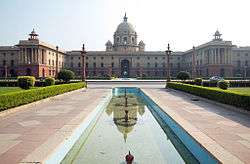 Cabinet Secretariat of India located at South Block of the building | |
 Location in New Delhi, India | |
| General information | |
| Architectural style | Delhi Order |
| Location | New Delhi, India |
| Construction started | 1912 |
| Completed | 1927 |
| Technical details | |
| Floor area | 148,000 sq ft (13,700 m2) |
| Design and construction | |
| Architect | Herbert Baker |
The Secretariat Building or Central Secretariat is where the Cabinet Secretariat is housed, which administers the Government of India. Built in the 1910s, it is home to some of the most important ministries of the Cabinet of India. Situated on Raisina Hill, New Delhi, the Secretariat buildings are two blocks of symmetrical buildings (North Block and South Block) on opposite sides of the great axis of Rajpath, and flanking the Rashtrapati Bhavan (President's House).
History
The planning of New Delhi began in earnest after Delhi was made capital of the British Indian Empire in 1911. Lutyens was assigned responsibility for town planning and the construction of Viceroy's House (now Rashtrapati Bhavan); Herbert Baker, who had practised in South Africa for two decades, 1892–1912, joined in as the second in command. Baker took on the design of the next most important building, the Secretariat, which was the only building other than Viceroy's House to stand on Raisina Hill. As the work progressed relations between Lutyens and Baker deteriorated; the hill placed by Baker in front of Viceroy's House largely obscured Viceroy's House from view on the Rajpath from India Gate, in breach of Lutyens' intentions; instead, only the top of the dome of Viceroy's House is visible from far away. To avoid this, Lutyens wanted the Secretariat to be of lower height than Viceroy's House, but Baker wanted it of the same height, and in the end it was Baker's intentions that were fulfilled.[1]
After the capital of India moved to Delhi, a temporary secretariat building was constructed in a few months in 1912 in North Delhi. Most of the government offices of the new capital moved here from the 'Old Secretariat' in Old Delhi, a decade before the new capital was inaugurated in 1931. Many employees were brought into the new capital from distant parts of British India, including the Bengal Presidency and Madras Presidency. Subsequently housing for them was developed around Gole Market area.[2]
The Old Secretariat Building now houses the Delhi Legislative Assembly.[3] The nearby Parliament House was built much later, and hence was not constructed around the axis of Rajpath. Construction of Parliament House was begun in 1921, and the building was inaugurated in 1927.
Today, the area is served by the Central Secretariat station of the Delhi Metro.
Architecture
The Secretariat Building was designed by the prominent British architect Herbert Baker in Indo-Saracenic Revival architecture. Both the identical building have four levels, each with about 1,000 rooms, in the inner courtyards to make space for future expansions. In continuation with the Viceroy's House, these buildings also used cream and red Dholpur sandstone from Rajasthan, with the red sandstone forming the base. Together the buildings were designed to form two squares. They have broad corridors between different wings and wide stairways to the four floors and each building is topped by a giant dome, while each wings end with colonnaded balcony.
Much of the building is in classical architectural style, yet it incorporated from Mughal and Rajasthani architecture style and motifs in its architecture. These are visible in the use of Jali, perforated screens, to protect from scorching sun and monsoon rains of India. Another feature of the building is a dome-like structure known as the Chatri, a design unique to India, used in ancient times to give relief to travelers by providing shade from the hot Indian sun.
The style of architecture used in Secretariat Building is unique to Raisina Hill. In front of the main gates on buildings are the four "dominion columns", given by Canada, Australia, New Zealand and South Africa. At the time of their unveiling in 1930, India was also supposed to become a British dominion soon. However, India became independent within the next 17 years and the Secretariat became the seat of power of a sovereign India. In the years to follow the building ran out of accommodation.[1]
| Images of Secretariat Building | ||||||||||||||
|---|---|---|---|---|---|---|---|---|---|---|---|---|---|---|
|
Similarities with Union Buildings, Pretoria
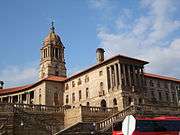 |
|
| The Bell tower and colonnaded balcony, Union Buildings | The Bell tower and colonnaded balcony, Secretariat Building |
Prior to coming to India, Baker had an established practice in South Africa over twenty years and designed various prominent buildings there, especially the Union Buildings, in Pretoria, built from 1910 to 1913, though designed in 1908. It is the official seat of the South African government, house the offices of the President of South Africa, and most interestingly like the Secretariat Building, it also sits atop a hill, known as the Meintjieskop.
But the similarities between the two building show a clear influence of the former, especially in the basic structure of two wings and colonnaded balconies at the end with almost identical symmetrical bell towers. Both buildings have a similar symmetrical design in case of the Union Building the two wings are joined by a semi-circular colonnade, while with Secretariat building, the North and South Blocks are separated and face each other. The colour scheme is reversed while the roof of Union Building is covered with red tiles, in secretariat red sandstone is used in the ground floor walls only, the rest is the same pale sandstone.[1]
Ministries and offices in the Secretariat Building
The Secretariat Building houses the following ministries:
| Ministry/Department Serial | Name of Ministry/Department | Ministry/Department abbreviated as | Block |
|---|---|---|---|
| Ministry number 1 | Ministry of Defence | (MoD) | South |
| Ministry number 2 | Ministry of Finance | (MoF) | North |
| Ministry number 3 | Ministry of External Affairs | (MEA) | South |
| Ministry number 4 | Ministry of Home Affairs | (MHA) | North |
| Office | CBDT Chairman | (CBDT) | North |
| Office | Prime Minister Office | (PMO) | South |
| Office | National Security Advisor | NSA | South |
| Office | Indian Foreign Secretary | South | |
| Office | Cabinet Secretary | South |
The Secretariat Building consists of two buildings: the North Block and the South Block. Both the buildings flank the Rashtrapati Bhavan.
- The South Block houses the Prime Minister's Office, Ministry of Defence and the Ministry of External Affairs.
- The North Block primarily houses the Ministry of Finance and the Home Ministry.
The terms 'North Block' and 'South Block' are often used to refer to the Ministry of Finance and the Ministry of External Affairs respectively.
See also
References
- 1 2 3 "The building Blocks of British empire". Hindustan Times. June 7, 2011.
- ↑ "Capital story: Managing a New Delhi". Hindustan Times. September 1, 2011.
- ↑ "Architectural marvels for the new capital". Hindustan Times. July 20, 2011.
External links
| Wikimedia Commons has media related to Secretariat Building, New Delhi. |
- Cabinet Secretariat, Government of India, Official website
- Ministry of External Affairs' website: About South Block
- Historic Architecture of "New Delhi" - India
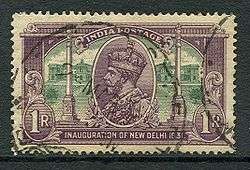
.jpg)
